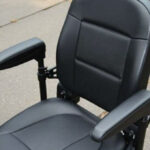How to change bike tire rear is a skill every cyclist should have to ensure smooth and uninterrupted rides. Knowing how to quickly and efficiently replace your rear tire can save you from being stranded on the road. Whether you’re dealing with a puncture, setting up your bike for a trainer session, or simply dismantling it for transport, these situations call for a tire change.
Here’s what you need to do:
1. Shift to the highest gear to align the chain with the smallest cog.
2. Open the rear brake by loosening the tension screw.
3. Use a wrench or bike tool to loosen the wheel axle if necessary.
4. Remove the rear wheel by pulling back the derailleur and lifting the bike.
5. Replace the tube or tire, ensuring the correct fit.
6. Reinstall the wheel, ensuring the chain is on the smallest cog.
7. Close the brake and secure the tension screw.
Changing a rear bike tire may seem daunting, especially with the gears and chain in play, but it’s easier than you think. Many riders worry about getting their hands greasy or messing up the gearing, but with careful steps, this task becomes simple. Preparing for common scenarios like flats can make your rides stress-free.
As one cyclist shared, “I was able to put [my tire] back on, and it wasn’t that hard.” With a bit of practice and the right tools, you can make tire changes a hassle-free part of your biking routine, whether you’re on a road bike, mountain bike, or an eBike. Keep your biking journeys smooth and enjoy the freedom of the open road with confidence.

Simple guide to how to change bike tire rear terms:
– analog cycles
– bike with led lights
– most comfortable bike seats
Tools Needed for Changing Your Rear Bike Tire
Before you tackle how to change a bike tire rear, gather these essential tools. Having the right gear makes the process much simpler and more efficient.
Spare Tube
A spare tube is your first line of defense against a flat tire. Make sure it’s the right size for your wheel. Check the diameter and width—common sizes are 29 inches in diameter and 2 inches in width. These numbers should be visible on your tire and tube packaging. While a 27.5-inch tube might work in a pinch, the correct size ensures a smoother replacement process.
Tire Lever
The tire lever is a small but mighty tool. It’s compact and lightweight, making it easy to carry on rides. This tool helps you pry the tire off the rim without damaging it. Every cyclist should have one in their toolkit.
Patch Kit
A patch kit is optional but highly recommended. It’s a lifesaver if you encounter multiple flats or forget your spare tube. These kits are small and can easily fit in your pocket or bike bag, providing a quick fix for punctures.
Wrench/Bike Tool
For those without quick-release wheels, a wrench or bike tool is necessary. These tools help you remove the wheel by loosening the bolts. If your bike has theft-proof skewers, you’ll need specialized tools to remove them. Always check what type of attachment your bike uses before heading out.
Inflation Device
Once you’ve replaced the tube, you’ll need an inflation device. There are several options:
- Floor Pump: Best for home use, providing a sturdy and efficient way to inflate your tire.
- Handheld Pump: Convenient for carrying on rides and suitable for quick fixes.
- CO2 Cartridge: Compact and lightweight, perfect for emergencies. However, note that CO2 may not last as long as regular air.
Make sure your inflation device is compatible with your tube’s valve type, whether it’s Presta or Schrader. Compatibility ensures you can inflate your tire without any hitches.

With these tools in hand, you’re well-equipped to handle any flat tire situation. Whether you’re on a leisurely ride or tackling rugged trails, being prepared keeps your biking trips smooth and stress-free.
Step-by-Step Guide on How to Change a Rear Bike Tire
Changing a rear bike tire might seem daunting, but with a little practice, you’ll be able to do it quickly and easily. Follow these steps to learn how to change a bike tire rear without hassle.
Step 1: Shift to the Highest Gear
Start by shifting your bike into the highest gear. This means moving the chain to the smallest gear cog on the rear wheel. Doing this reduces tension on the chain, making it easier to remove the wheel later.
Step 2: Open the Brake
Next, you’ll need to open the brake caliper. This step ensures that the wheel can be removed without getting stuck. To do this, loosen the tension screw on the back brake shoe. This will release the brake pads from the rim, giving you more room to work with.
Step 3: Remove the Rear Wheel
Now it’s time to remove the wheel. If your bike has a quick-release lever, you’re in luck—this makes the process much easier.
-
Open the Quick-Release Lever: Turn the lever to the open position. This will loosen the wheel from the frame.
-
Pull Back the Derailleur: With your right hand, pull back the derailleur. This action shifts the chain out of the way.
-
Lift the Bike: With the derailleur pulled back, lift the bike by the seat. The wheel should drop out easily. If it doesn’t, give it a gentle tap to help it along.
Step 4: Replace the Tire or Tube
With the wheel off, you can now replace the damaged tube or tire.
-
Remove the Old Tire: Use a tire lever to pry the tire off the rim. Be careful not to damage the rim or the new tube.
-
Install the New Tire or Tube: Place the new tube inside the tire, making sure it fits snugly. Then, push the tire back onto the rim. Ensure it’s seated properly to avoid any future issues.

Step 5: Reinstall the Rear Wheel
Finally, it’s time to put the wheel back on the bike.
-
Align the Chain: Before securing the wheel, make sure the chain is aligned with the smallest gear cog.
-
Secure the Quick Release: Close the quick-release lever to lock the wheel into place. It should be tight enough to hold the wheel securely, but not so tight that it’s difficult to open again.
-
Tighten the Tension Screw: Re-engage the brake by tightening the tension screw on the brake shoe. This ensures your brakes will work properly once you’re back on the road.
With these steps, you should be able to change a rear bike tire with confidence. Practice makes perfect, so don’t be afraid to try it a few times to get the hang of it. Next, we’ll explore some tips to make tire replacement even easier!
Tips for Easier Tire Replacement
Changing a rear bike tire can be tricky, but a few tips can make it much easier. Let’s explore some practical advice on how to simplify the process.
Flipping the Bike
One common method to make tire replacement easier is flipping the bike upside down. This allows the bike to rest on its handlebars and saddle, providing stability while you work.
Pros:
– Provides a stable base.
– Makes it easier to access the wheel and chain.
Cons:
– Potential for scratches on handlebars, shifters, or saddle.
– Not ideal for bikes with delicate components or accessories.
If you’re concerned about scratches, consider placing a soft cloth underneath the handlebars and saddle or using an upright bike stand.
Using a Friend or Tree Branch
If flipping the bike isn’t your style, enlisting the help of a friend or using a tree branch can be excellent alternatives.
Using a Friend:
– A friend can hold the bike steady while you work, keeping the bike upright and avoiding potential damage.
Using a Tree Branch:
– Hook the nose of the saddle over a low tree branch to keep the bike liftd. This method is particularly useful if you’re out on a trail.
Both methods help avoid scratches and damage, making the process smoother and more efficient.
Handling Different Wheel Attachment Methods
Understanding your bike’s wheel attachment method is crucial for a smooth tire change. Here are the most common types:
Quick Release:
– Uses a lever to secure or release the wheel quickly.
– Simply flip the lever to loosen and remove the wheel.
Thruaxle:
– A more robust system where the axle screws directly into the frame.
– Requires a hex tool to remove. Slide the axle out from the non-drive side.
Nuts and Locknuts:
– Found on older bikes, these require a wrench to loosen the nuts.
– Make sure to keep the nuts safe to avoid losing them during the process.
Each method has its own steps, but understanding them will make removing and installing the wheel much easier. Knowing these tips and tricks will prepare you for any situation, whether you’re on a leisurely ride or tackling a challenging trail.
Frequently Asked Questions about How to Change Bike Tire Rear
Changing a rear bike tire can seem daunting, but with some quick answers to common questions, it becomes much more manageable. Let’s address some frequently asked questions to help you become a pro at tire changes.
How to Change the Rear Tire of a Bike?
To change the rear tire of your bike, start by ensuring the battery power is off if you’re working with an electric bike. Disconnect the motor cable to prevent any damage during the process.
- Shift to the smallest gear on your bike. This step reduces chain tension, making it easier to remove the wheel.
- Open the brake caliper to give the tire room to pass through.
- Use a quick-release lever or appropriate tool to detach the wheel.
- Remove the old tire and tube, then replace them with new ones, ensuring the bead of the tire sits properly in the center of the rim.
- Reattach the wheel, reconnect the motor cable, and power on the bike.
How to Take Off a Rear Bike Wheel?
Removing a rear bike wheel involves a few simple steps:
- Shift to the smallest gear on the rear cog. This reduces chain tension and makes it easier to handle the derailleur.
- Open the brake caliper to allow the wheel to pass through.
- Use the quick-release lever or a wrench to detach the wheel. Pull back the derailleur gently to slide the wheel out smoothly.
- Lift the bike slightly to remove the wheel completely.
How to Change a Bike Tire Without Tire Levers?
If you find yourself without tire levers, don’t worry. You can still change your bike tire using alternative methods:
- Deflate the tire completely to make it easier to work with.
- Use your thumbs to push the tire bead towards the center of the rim all around the wheel. This creates slack, making it easier to remove the tire.
- Carefully use a spoon or a blunt tool, like the back of a plastic knife, to pry the tire off the rim. Be gentle to avoid damaging the tire.
- Once the tire is off, change the tube or tire as needed and ensure the bead is seated correctly when reinstalling.
With these answers, you should feel more confident tackling a rear tire change. Practice makes perfect, so don’t hesitate to try these steps a few times to get comfortable with the process.
Conclusion
Preparation is key when it comes to changing a rear bike tire. Having the right tools and understanding the steps can make the process much smoother and less intimidating. As we’ve seen, shifting to the smallest gear and opening the brake caliper are essential first steps that set you up for success.
Practice makes perfect. The more you familiarize yourself with the process, the quicker and more efficiently you’ll be able to replace your tire when the need arises. Don’t be discouraged if it takes a few tries to get it right—each attempt builds your confidence and skill.
At Doot Scoot, we’re committed to providing you with helpful guides and resources to make your biking experience as enjoyable and stress-free as possible. Whether you’re a seasoned rider or new to biking, our aim is to support you every step of the way. For more helpful tips and guides on sustainable urban transport, be sure to check out our Doot Scoot service page. Let’s keep you rolling smoothly and sustainably!










